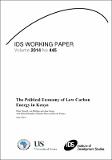| dc.contributor.author | Newell, Peter | |
| dc.contributor.author | Phillips, Jon | |
| dc.contributor.author | Pueyo, Ana | |
| dc.contributor.author | Kirumba, Edith | |
| dc.contributor.author | Ozor, Nicolas | |
| dc.contributor.author | Urama, Kevin | |
| dc.coverage.spatial | Kenya | en_GB |
| dc.date.accessioned | 2014-06-20T09:36:58Z | |
| dc.date.available | 2014-06-20T09:36:58Z | |
| dc.date.issued | 2014-06-20 | |
| dc.identifier.isbn | 978 1 78118 182-9 | |
| dc.identifier.uri | https://opendocs.ids.ac.uk/opendocs/handle/20.500.12413/4049 | |
| dc.description.abstract | There is growing international focus on how to support more integrated approaches to addressing climate change in ways that capture synergies and minimise the trade-offs between climate change mitigation, adaptation and development. These aims are embodied in the concept of climate compatible development (CCD). But what does this look like in practice in Kenya?
With a National Action Plan on Climate Change, a Vision 2030 Strategy, a new constitution and a revised Energy Policy, Kenya is at a critical cross-roads with respect to defining its energy future for the years to come. The challenge is to enable a just transition to a lower carbon economy that delivers poverty reduction and climate resilience at the same time. But thinking about who sets the terms of transition and for whom, raises key political questions about the role of actors, interests and institutions in the energy sector. In other words, who has the power to change power?
Drawing on 29 interviews with government officials, donors and businesses conducted during 2013, insights gleaned from an interactive workshop with practitioners on the themes of the research, as well as available academic and grey literature, this paper explores the role of politics, actors and institutions in enabling or frustrating the pursuit of climate compatible energy development in Kenya. This is a critical time for Kenya in deciding its energy future and whether and how it will aim to make it ‘climate compatible’. Issues of power and political economy will play a key role in determining technological and social outcomes: the winners and losers from different energy pathways and on whose terms and how the trade-offs between competing policy objectives are resolved. In particular political economy analysis helps to understand the potential for energy systems to meet climate, development and adaptation needs simultaneously. | en_GB |
| dc.language.iso | en | en_GB |
| dc.relation.ispartofseries | IDS Working Paper;445 | |
| dc.rights | This publication is copyright, but may be reproduced by any method without fee for teaching or nonprofit purposes, but not for resale. Formal permission is required for all such uses, but normally will be granted immediately. For copying in any other circumstances, or for re-use in other publications, or for translation or adaptation, prior written permission must be obtained from the publisher and a fee may be payable. | en_GB |
| dc.rights.uri | http://www.ids.ac.uk/files/dmfile/IDSOpenDocsStandardTermsOfUse.pdf | en_GB |
| dc.subject | Climate Change | en_GB |
| dc.title | The Political Economy of Low Carbon Energy in Kenya | en_GB |
| dc.type | IDS Working Paper | en_GB |
| dc.rights.holder | Institute of Development Studies | en_GB |
| dc.identifier.team | Globalisation | en_GB |

